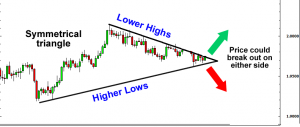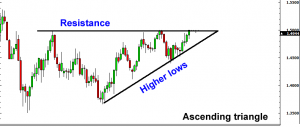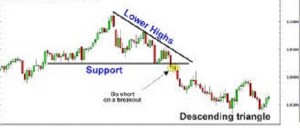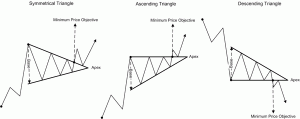Technical analysis is the science of predicting the futures by studying the price charts based on the pattern formations. Chart patterns are of two types – reversal and continuation. Today we are going to discuss one of the continuation pattern which in itself is a complete set of technical chart patterns. Before we examine them in detail, however, a quick review of the basic theory, which gives meaning and value to technical analysis, may be appropriate. That theory can be summarized in the following brief statements.
- The market value of a security is determined solely by the interaction of supply and demand.
- Supply and demand are governed at any given moment by many hundreds of factors, some rational and some irrational. Information, opinions, moods, guesses (shrewd or otherwise) as to the future combine with blind necessities in this equation. No ordinary man can hope to grasp and weigh them all, but the market does this automatically.
- Disregarding Minor Fluctuations, prices move in trends that persist for an appreciable length of time.
- Changes in trend, which represent an important shift in the balance between supply and demand, however caused, are detectable sooner or later in the action of the market itself.
Triangles are of three types – symmetrical triangle, ascending triangle and descending triangle.
Symmetrical triangle
The symmetrical triangle, which can also be referred to as a coil, usually forms during a trend as a continuation pattern. The pattern contains at least two lower highs and two higher lows. When these points are connected, the lines converge as they are extended and the symmetrical triangle takes shape. You could also think of it as a contracting wedge, wide at the beginning and narrowing over time.
While there are instances when symmetrical triangles mark important trend reversals, they more often mark a continuation of the current trend. Regardless of the nature of the pattern, continuation or reversal, the direction of the next major move can only be determined after a valid breakout.
Ascending triangle
The ascending triangle is a bullish formation that usually forms during an uptrend as a continuation pattern. There are instances when ascending triangles form as reversal patterns at the end of a downtrend, but they are typically continuation patterns. Regardless of where they form, ascending triangles are bullish patterns that indicate accumulation.
Descending triangle
The descending triangle is a bearish formation that usually forms during a downtrend as a continuation pattern. There are instances when descending triangles form as reversal patterns at the end of an uptrend, but they are typically continuation patterns. Regardless of where they form, descending triangles are bearish patterns that indicate distribution.
General Rules for triangles
Trend: In order to qualify as a continuation pattern, an established trend should exist. The trend should be at least a few months old and the symmetrical triangle marks a consolidation period before continuing after the breakout.
Four (4) Points: At least 2 points are required to form a trend line and 2 trend lines are required to form a symmetrical triangle. Therefore, a minimum of 4 points are required to begin considering a formation as a symmetrical triangle. The second high (2) should be lower than the first (1) and the upper line should slope down. The second low (2) should be higher than the first (1) and the lower line should slope up. Ideally, the pattern will form with 6 points (3 on each side) before a breakout occurs.
Volume: As the symmetrical triangle extends and the trading range contracts, volume should start to diminish. This refers to the quiet before the storm, or the tightening consolidation before the breakout.
Duration: The length of the triangles can range from a few weeks to many months, with the average pattern lasting from 1-3 months.
Here we have discussed triangles as continuation patterns. But, triangles can be continuation as well as reversal patterns. So should be used with caution.




